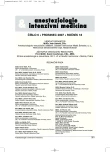Lipid resuscitation: Progress in the pharmacology of local anaesthetics – a view from the perspective of the year 2007
Authors:
M. Horáček
Authors‘ workplace:
Klinika anesteziologie a resuscitace, FN v Motole a IPVZ, Praha
Published in:
Anest. intenziv. Med., 18, 2007, č. 6, s. 335-339
Category:
Anaesthesiology
Overview
The popularity of peripheral nerve blocks is steadily increasing. Due to the high doses of local anaesthetics used in these techniques the incidence of toxic reactions could rise. In this review we discuss the current knowledge of the pathophysiology, diagnosis and treatment of the cardiotoxicity of local anaesthetics. Cardiotoxicity induced by 22 mg of bupivacaine in a patient with isovaleric acidaemia stimulated research of local anaesthetics effects on mitochondria. In animal studies a lipid emulsion reversed cardiotoxic signs and symptoms. Its beneficial effect has been confirmed by five published case reports in humans. The mechanism of action of the lipid emulsion is explained and guidelines for its use in the treatment of cardiotoxicity are presented. A possible role of a lipid emulsion in the management of intoxications by other lipophilic drugs is suggested.
Key words:
local anaesthetics – cardiotoxicity – lipid emulsions – resuscitation
Labels
Anaesthesiology, Resuscitation and Inten Intensive Care MedicineArticle was published in
Anaesthesiology and Intensive Care Medicine

2007 Issue 6
Most read in this issue
- Neuromodulation in chronic pain management
- Cardiocerebral resuscitation: For laymen without ventilation?
- Advances in general anaesthesia
- Lipid resuscitation: Progress in the pharmacology of local anaesthetics – a view from the perspective of the year 2007
